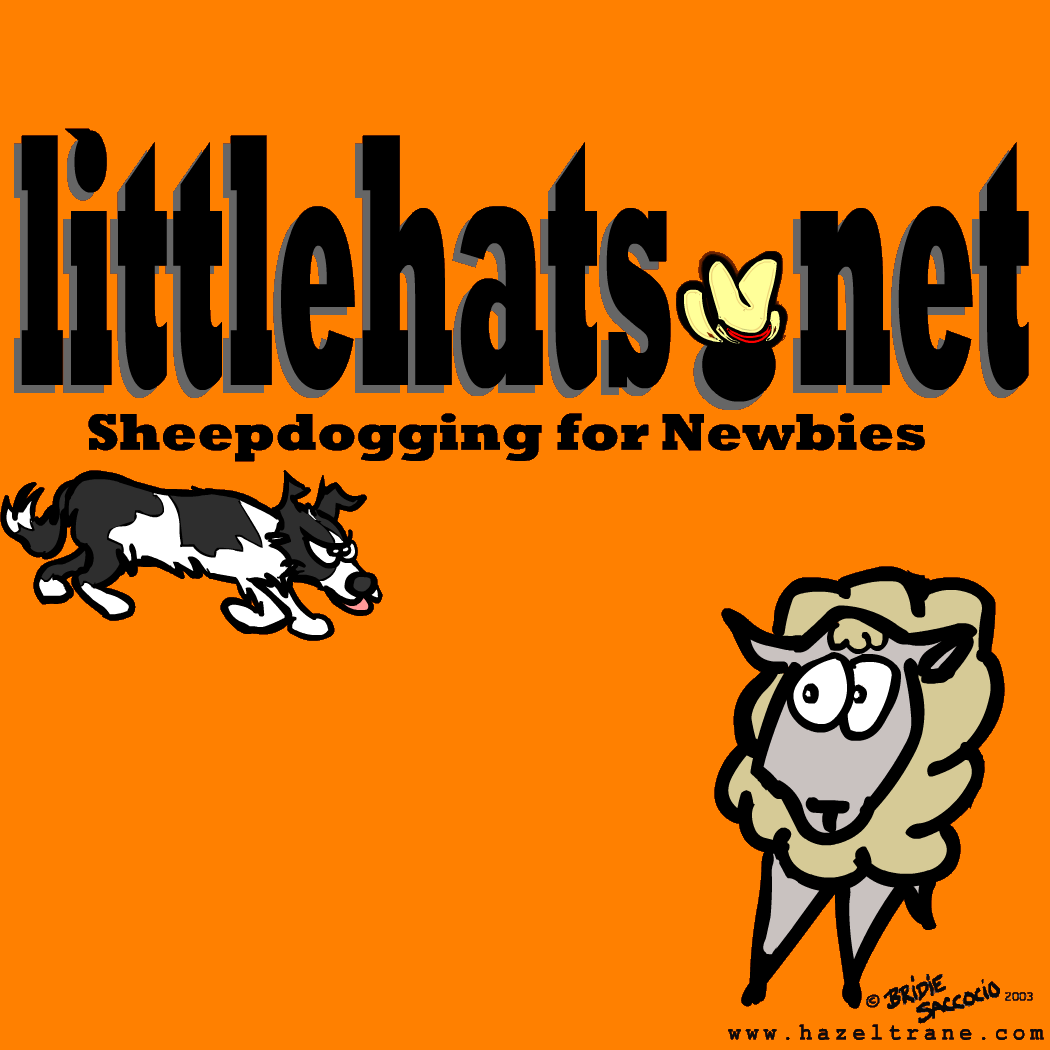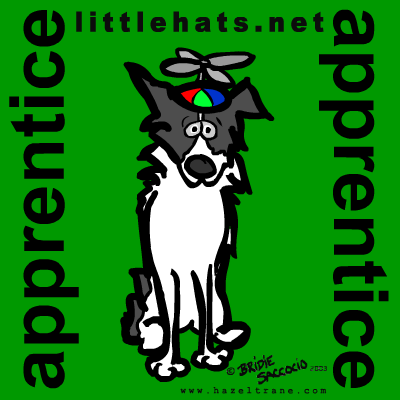


Teaching Redirects
by Angie Coker
Search This Site
Originally Published in Working Collie Magazine. Reprinted with permission.
When I start lengthening the outrun on a dog I start incorporating redirects. I try to be careful here as I want to CORRECT the dog when he's wrong, not just give another command, which he could start relying on if he doesn't learn to do his outrun properly in the beginning. So in the early stages of outruns, say 100 - 200 yards I really want to correct the dogs for being tight, which in my mind is a "HEY GET OUT OF THAT", not just another whistle command.
The redirect commands I use to get my dogs out wider on the outrun are just a repeat of the flank command I've already given the dog. However I will try and change the whistle length a little by making it a longer more drawn out sound. When I want to start trying to get the dog to widen out with a command I'll send the dog out as I normally would. I'll let him go a quarter to half way out stop him and repeat the command, if I'm using the whistle I'll try and draw it out longer as I said before. If he doesn't widen out a little, I'll stop him again and walk out to him, position myself between the dog and the sheep and give the drawn out whistle command again. If you only have a small field to work in and want to work on redirects try walking the dog up toward the set out sheep then giving the flank whistle, this should help to get the dog to flair out somewhat. I'll repeat this until I get the dog going out a little wider, how much wider the dog goes can depend a lot on whether he's easy to push out and more of a natural out runner or not. If he were I'd probably expect to see him get out a good bit, if not I'd expect to see a little difference over time. I'd repeat this process until I started seeing him widen out more, it's not something I'd do every day are even every week, just often enough to see some progress.
A lot of times the real test to see how obedient a dog is and how willing he is to take a redirect is to give him one when he thinks he knows where the sheep are. I've found it harder to give a dog a redirect when he thought he knew where the sheep were opposed to when he had no idea where they were. For this reason I'll work on giving redirects when the sheep are out of sight.
The field I like to use for this is about 350 yards long and 400 wide, it has a small hill in the center of it running the length of the field. The dogs get use to running on either side of the hill and not having to go over the hill, so they never really loosing sight of the sheep. To change things up for them and see how well they are listening I'll set the sheep in the far corner of the field over the hill. If I'm on the right side of the hill I'll have sheep spotted on the far left of it and send my dog to the left and visa versa. Of course the young dogs and sometimes the old ones think the sheep are hidden straight in the back, wrong, so I get to stop them and redirect them. With young dogs I may have to stop them several times and go out to them each time giving them my modified flank whistle. This is a great exercise for teaching the dog to listen, trust what I say and look for the sheep. In my mind every time I help my dog find sheep his confidence and trust in me will grow, making us a better team.
Once the dog gets the idea of stopping and taking the redirect, I'll set up the same situation as above, and try giving the redirect without stopping him. Some dogs seem to take the redirect on the go naturally while others just speed up, thus needing to be stopped to get them out wider.
It seems like I'm always getting onto people for pushing their dogs out all the time, trying to get them wider on the outrun, when so often the outrun will develop over time without constant pushing. I'm saying this because care has to be taken when trying to put a redirect like this on a dog. It is in fact pushing the dog out, and if the dog has a tendency to get wider (as many dogs do as they get older) one might find themselves trying to put a call in redirect on their dog. If the dog wants to go wider the first time I try the redirect that's great, I won't keep doing it over and over, it's just something I'll work on once in a while to make sure my dog can and will do it.
The redirect commands I use to get my dogs out wider on the outrun are just a repeat of the flank command I've already given the dog. However I will try and change the whistle length a little by making it a longer more drawn out sound. When I want to start trying to get the dog to widen out with a command I'll send the dog out as I normally would. I'll let him go a quarter to half way out stop him and repeat the command, if I'm using the whistle I'll try and draw it out longer as I said before. If he doesn't widen out a little, I'll stop him again and walk out to him, position myself between the dog and the sheep and give the drawn out whistle command again. If you only have a small field to work in and want to work on redirects try walking the dog up toward the set out sheep then giving the flank whistle, this should help to get the dog to flair out somewhat. I'll repeat this until I get the dog going out a little wider, how much wider the dog goes can depend a lot on whether he's easy to push out and more of a natural out runner or not. If he were I'd probably expect to see him get out a good bit, if not I'd expect to see a little difference over time. I'd repeat this process until I started seeing him widen out more, it's not something I'd do every day are even every week, just often enough to see some progress.
A lot of times the real test to see how obedient a dog is and how willing he is to take a redirect is to give him one when he thinks he knows where the sheep are. I've found it harder to give a dog a redirect when he thought he knew where the sheep were opposed to when he had no idea where they were. For this reason I'll work on giving redirects when the sheep are out of sight.
The field I like to use for this is about 350 yards long and 400 wide, it has a small hill in the center of it running the length of the field. The dogs get use to running on either side of the hill and not having to go over the hill, so they never really loosing sight of the sheep. To change things up for them and see how well they are listening I'll set the sheep in the far corner of the field over the hill. If I'm on the right side of the hill I'll have sheep spotted on the far left of it and send my dog to the left and visa versa. Of course the young dogs and sometimes the old ones think the sheep are hidden straight in the back, wrong, so I get to stop them and redirect them. With young dogs I may have to stop them several times and go out to them each time giving them my modified flank whistle. This is a great exercise for teaching the dog to listen, trust what I say and look for the sheep. In my mind every time I help my dog find sheep his confidence and trust in me will grow, making us a better team.
Once the dog gets the idea of stopping and taking the redirect, I'll set up the same situation as above, and try giving the redirect without stopping him. Some dogs seem to take the redirect on the go naturally while others just speed up, thus needing to be stopped to get them out wider.
It seems like I'm always getting onto people for pushing their dogs out all the time, trying to get them wider on the outrun, when so often the outrun will develop over time without constant pushing. I'm saying this because care has to be taken when trying to put a redirect like this on a dog. It is in fact pushing the dog out, and if the dog has a tendency to get wider (as many dogs do as they get older) one might find themselves trying to put a call in redirect on their dog. If the dog wants to go wider the first time I try the redirect that's great, I won't keep doing it over and over, it's just something I'll work on once in a while to make sure my dog can and will do it.